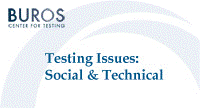Buros-Nebraska Series on Measurement and Testing
Date of this Version
1984
Document Type
Article
Citation
Published in Social and Technical Issues in Testing: Implications for Test Construction and Usage, edited by Barbara S. Plake (Hillsdale, NJ: Lawrence Erlbaum Associates, 1984).
Abstract
The writer of achievement test items is confronted with two major problems, as Lindquist pointed out nearly half a century ago (Lindquist, 1936, p. 17). The first of these is the problem of what to measure. The second is how to measure it. The solution proposed for the first problem is to focus primarily on testing for knowledge and only secondarily on testing for abilities. Cognitive abilities, it is reasonable to believe, depend entirely on knowledge. Although the term knowledge, as commonly used, includes both information and understanding, the most useful kind of knowledge, the kind that will occupy our attention almost exclusively, is that which involves understanding. Understood knowledge is a structure of relations among concepts. To understand is to be aware of relationships. Each of these relationships can be expressed in words as a proposition.
The solution proposed for the second problem is to present the examinee with a series of incomplete propositions, accompanied by two or more alternative completions, only one of which makes the proposition true. Many of the current issues in the writing of achievement test items are related to these two proposed solutions.
A CONCEPTION OF KNOWLEDGE
Knowledge originates in information that can be received directly from observations or indirectly from reports of observations. These observations may be external (objects or events) or internal (thoughts and feelings) (Scheffler, 1965, p. 137). Information feeds the mind and, like food for the body, it must be digested and assimilated. Thinking is the process by which these things can be accomplished (Newman, 1852, p. 134). Information that is simply stored in memory remains only information, the lowest, least useful form of knowledge. But if the information becomes the subject of reflective thought, if those who received it ask themselves, "What does it mean?" "How do we know?" "Why is it so?” the information may come to be understood. It may be integrated into a system of relations among concepts and ideas that constitutes a structure of knowledge. This has been referred to as "semantic encoding" (Anderson, 1972, p. 146). Information that is understood, that is incorporated into a structure of knowledge, tends to be more powerful, more useful, and more satisfying. It is likely to be a more permanent possession than information that is simply remembered (Boulding, 1967, pp. 7- 8).
The basis for verbal knowledge exists in the mind in a form that Polanyi (1958) has called "tacit knowledge." In that form, it is a purely private possession. But if concepts can be abstracted from these images and expressed in words, and if the relations among the concepts can be expressed in sentences, then tacit knowledge is converted into verbal knowledge. This can be communicated and thus made public. It can also be recorded and stored for future reference. It can be manipulated in the processes of reflective thinking. It is thus a very powerful form of knowledge. The peculiar excellence of human beings among all other creatures on earth is their ability to produce and to use verbal knowledge. Thinkers produce it. Teachers and students, planners, and managers use it. Classrooms and libraries and study rooms are full of it. So are conference rooms, memoranda, and reports. It would be difficult to overstate the importance of structures of verbal knowledge in human affairs (Hayakawa, 1941, pp. 15-25; Langer, 1957, pp. 200- 204).


Comments
Copyright © 1984 by Lawrence Erlbaum Associates. Digital edition copyright © 2012 Buros Center for Testing. This book may be downloaded, saved, and printed by an individual for their own use. No part of this book may be re-published, re-posted, or redistributed without written permission of the holder of copyright.